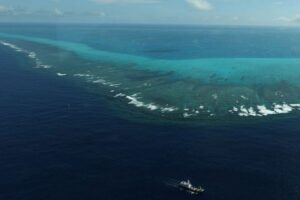Philippines says Chinese navy helicopter shadowed its aircraft
THE PHILIPPINES said on Wednesday its fisheries bureau aircraft was shadowed and approached by a Chinese navy helicopter while on patrol near the disputed Scarborough Shoal, in another face-off between two countries locked in a bitter row over territory. The Philippine National Security Council (NSC) said the incident took place on Monday and its aircraft […]

THE PHILIPPINES said on Wednesday its fisheries bureau aircraft was shadowed and approached by a Chinese navy helicopter while on patrol near the disputed Scarborough Shoal, in another face-off between two countries locked in a bitter row over territory.
The Philippine National Security Council (NSC) said the incident took place on Monday and its aircraft was still able to complete its mission. China’s embassy in Manila did not immediately respond to a request for comment.
It was the latest in the series of air and sea encounters between the two countries that have sparred over contested areas of the South China Sea, including the Scarborough Shoal, one of Asia’s most contested features, which has been occupied by China’s coast guard for more than a decade.
China’s actions violated air safety regulations, the NSC said in a statement.
Based on its interpretation of old maps, China claims almost the entire South China Sea, including the Scarborough Shoal, coveted for its bountiful fish stocks and a stunning turquoise lagoon.
The shoal, named after a British vessel that got stuck there centuries ago, is located 200 km (124 miles) off the Philippines, inside its exclusive economic zone (EEZ).
A 2016 ruling by the Permanent Court of Arbitration found China’s sweeping claims were not supported by international law, a decision Beijing refuses to recognize.
The tribunal did not determine sovereignty over the Scarborough Shoal, which it said was a traditional fishing ground for several countries.
CHINESE ‘INTERFERENCE’
Separately, the Philippine defense minister told China on Wednesday to withdraw vessels from its EEZ and accused Beijing of trying to meddle in its defense activities, including its use of a US mid-range missile launcher for training.
Reuters reported last week the United States has no immediate plans to pull out the missile system, which can be equipped with cruise missiles capable of striking Chinese targets.
“China is saying that they are alarmed, but that is interference into our internal affairs,” Defense Secretary Gilberto Teodoro told reporters.
“Why don’t they lead by example? Destroy their nuclear arsenal. Remove all their ballistic missile capabilities. Get out of the West Philippine Sea, and get out of Mischief reef,” he added, referring to the Philippine EEZ and a manmade, militarized island built there by China.
China has expressed concern over the deployment of the Typhon system in the Philippines, accusing Washington of fueling an arms race.
Philippine military chief Romeo Brawner on Wednesday said if he had his way, “I would like to have the Typhons here in the Philippines forever.”
The Department of Foreign Affairs declined to comment over WhatsApp message.
This development gives rise to a need for government agencies, such as the Armed Forces of the Philippines (AFP) to “speed up interoperability” to counter China’s actions.
“The AFP and government agencies that are related to maritime and aerial security of the WPS (West Philippine Sea) must speed up interoperability,” Chester B. Cabalza, founding president of Manila-based International Development and Security Cooperation, told BusinessWorld in a Facebook Messenger chat.
“By doing so, we can counter China’s continuous aggression and hostility disrupting not only freedom of navigation but also freedom of overflight.” — John Victor D. Ordoñez with Reuters























